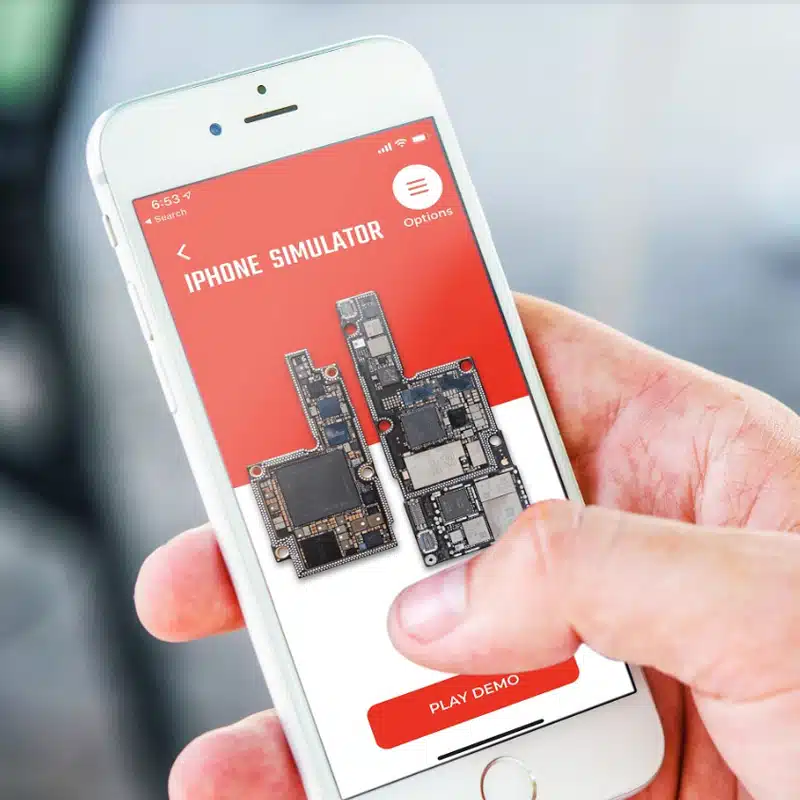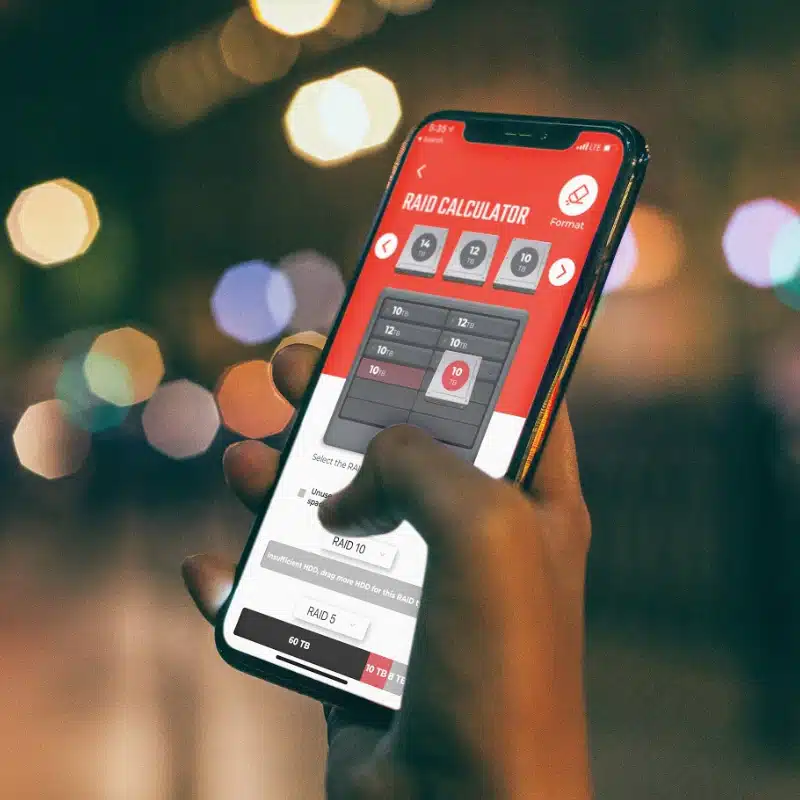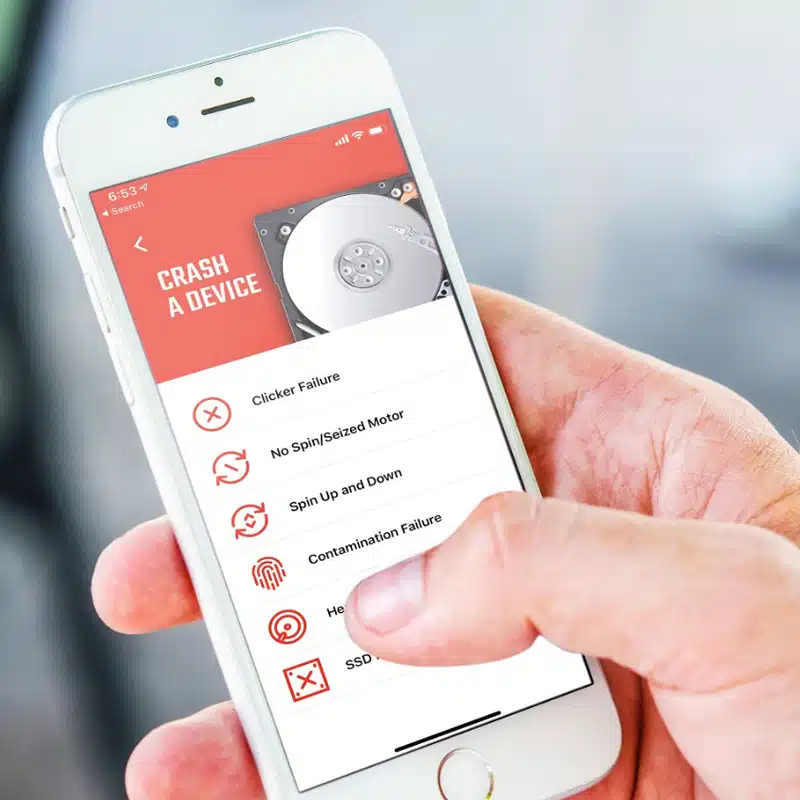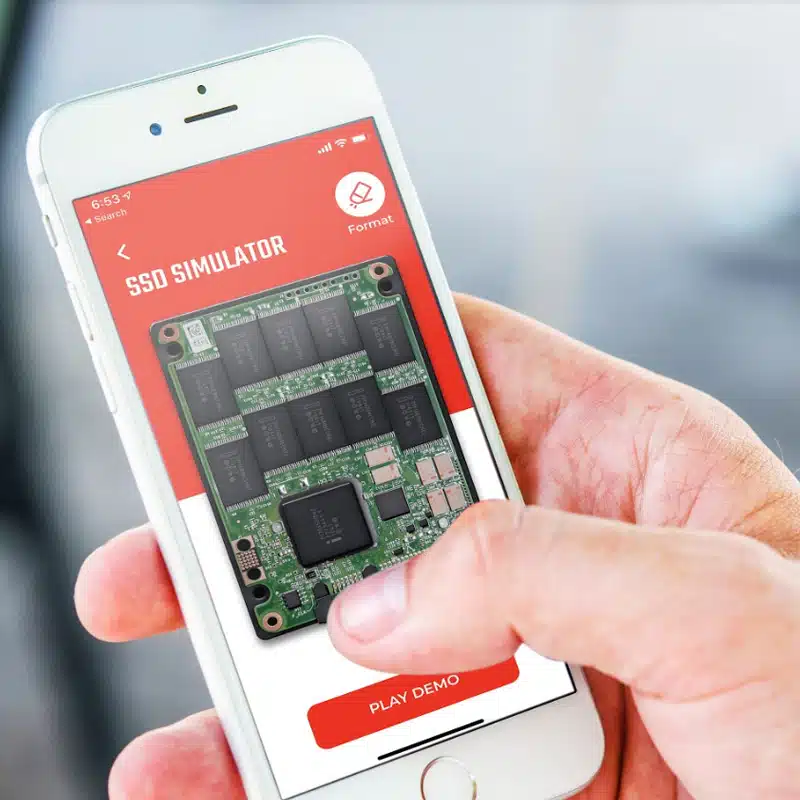Look Inside Data Storage Devices
In an attempt to change that, we developed DriveSaver®, the first and only storage device simulator available for all iOS and Android smartphones and tablets.
Using it, you can simulate various data storage devices like hard drives, solid-state drives, USB flash drives, SD cards, and smartphones.
But that’s not all; the application also allows you to crash a storage device. Many of us have heard a failing hard drive at some point; the clicking, whirring, and clunking sounds remind us of the nearing end. Now you can see the circumstances that instigated the chaos! DriveSaver® simulates different kinds of device failures.
Hard Disk Drive (HDD)
You might have a vague idea of how a typical hard drive rotates, but now you can witness it spin first-hand. You can flip it to see how it looks turned around or format it to see how the data gets erased.
If you want to learn more than just the mechanics of a modern-day hard drive, you can click the “Play Demo” button to learn more about its different parts. Click anywhere on the device to be told the part’s name and function. After playing the demo, you can tell the platter from the actuator and the voice coil from the air filter.
Solid State Drive (SSD)
DriveSaver® also allows you to look inside a solid-state device. SSDs are slowly replacing traditional hard disk drives because of their faster speeds, so this is a great chance to see exactly how the two are different. The data is arranged on memory chips instead of a platter, and there are no moving parts whatsoever!
Formatting an SSD is also a different experience because of the distinct distribution and storage of data. Click anywhere on the simulated device to learn more about its different parts, including the flash memory chip, printed circuit board, and data and power interfaces.
USB Flash Drive
Many of us have seen USB flash drives transfer data before our eyes. DriveSaver® allows you to look at their insides and learn more about them. Using the simulator, you can see where the memory chip is located and where the data controller is exactly on the circuit board. You can even see how a flash drive data format happens behind the scenes!
SD Card
These tiny specks of plastic-coated silicon can store hundreds of gigabytes of data. Within an SD card, small memory chips are located on the printed circuit board, and you can see the exact layout using DriveSaver®. Feel free to see what goes on behind the scenes when you choose to format an SD card.
Smartphone
We would never want to break into our phones, so this is a fantastic way of looking at one from the inside. See where the two battery cells are located, where the Wi-Fi module lies, and how the processor is connected to the main circuit board.
Throw some virtual water on its bare body (without any monetary repercussions), or completely destroy it by clicking on the “Damage” button. This is your personal demolition playground, and there are no rules whatsoever!

Stack the Hard Drives
in Your Favor
A RAID allows you to harness the potential of multiple interconnected hard drives in an attempt to create a more reliable data storage system. With the DriveSaver® RAID calculator, you can create different RAID configurations (RAID 0, RAID 1, RAID 5, RAID 6, RAID 10, RAID 50, RAID 60) with various hard drive or SSD arrangements. Choose different capacity drives and observe how the data gets striped depending on the capacities you select.
You will know how much usable space you have and how much will be used for protection and/or replication. Go through trial and error until you achieve the ideal RAID configuration.
(Note: Results generated by the RAID calculator should only be used for reference.)

Crash a Device Simulator
DriveSavers specialises in recovering data from all storage devices suffering from any malfunction and scenario. We included the 'Crash a Device Simulator' for you to experience how devices crash and the outcome.
DriveSaver® allows you to simulate common malfunctions that can cause a “crash” on different storage devices in the following ways:

Clicker
A “clicker” is when a hard disk drive (HDD) makes a clicking sound. This noise is generally the result of the read/write heads hitting the hard drive platters. Firmware corruption, damage to the actuator arm or media, a forceful impact, or a power surge can cause this. See what is happening and listen to a clicking hard drive.
No Spin/ Seized Motor
You may hear a zapping sound coming from the hard drive. This may be a mechanical or electrical failure that has affected the hard drive’s components, such as the printed circuit board (PCB), read/write heads, or spindle motor, causing the hard disk to stop doing what it is designed to do: spin. Listen to what this sounds like by using the simulator.
Spin Up / Spin Down
When a hard disk starts spinning up and down at will, it sounds like the dying ignition of a tiny car. This condition may be caused by a spindle motor that fails to reach the correct speed or by the drive failing on its self-tests. The simulated and real sounds are both alarming.
Contamination
Contamination is common with devices affected by fire or liquid or if a hard drive is opened outside of a certified cleanroom. If you open a device, you will not only void the warranty but also introduce contaminants that may cause a failure. In the simulator, you can touch the spinning hard drive and see how your fingerprint can cause contamination and damage. DriveSavers is authorised by all storage device manufacturers to open their products without voiding the original warranty.
Head Crash
A head crash is the most lethal kind of hard disk disaster. It occurs when the read/write heads make contact with the rotating platters. This failure may be caused by the head assembly’s impact, mishandling, or mechanical failure. It may start slowly, but if allowed to continue, this failure can destroy data beyond recovery. Use the simulator to watch as the read/write head at the end of the actuator arm literally scrapes data off the platter, causing absolute mayhem! In some cases, DriveSavers is still able to recover the data.
SSD Failure
Solid-state drives (SSDs) are a growing choice for data storage. They weigh less than HDDs, are faster, use less power, and have virtually no vibration due to no moving parts. However, they are still prone to failures from electrostatic discharge or firmware corruption. Use our SSD failure simulator to see how an SSD fails.
Need Data Recovery?
Device failure doesn’t mean that your data is lost forever. DriveSavers has been recovering data since 1985 and specialises in recovering data from the deepest pits of uncertainty. If your storage device has failed, appears to be corrupted, or you accidentally deleted all the data, we can help you reclaim everything that you lost!
Call DriveSavers at 1 (800) 440-1904 to request a free estimate!






